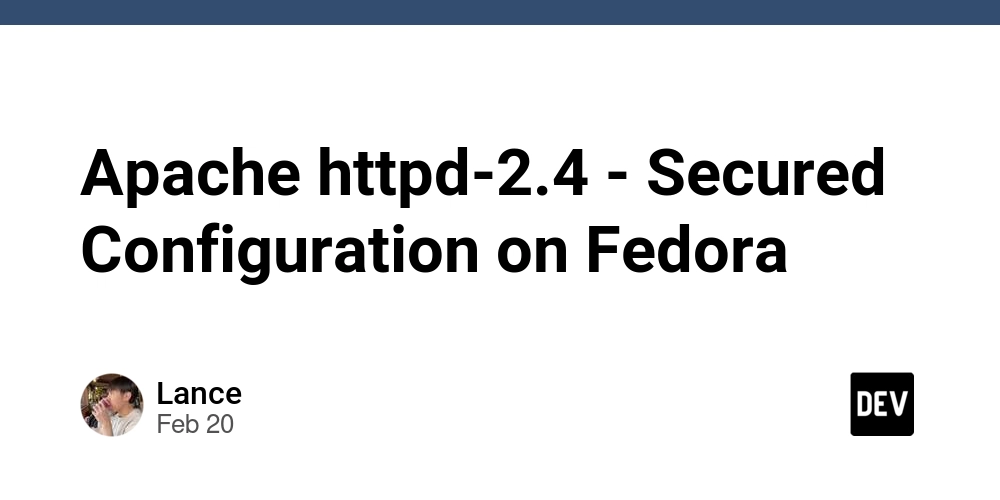Apache httpd-2.4 - Secured Configuration on Fedora
To configure a secured Apache HTTP/2.4 on Fedora, you need to install the Apache web server, enable the necessary modules like mod_ssl for SSL encryption and mod_http2 for HTTP/2 support, and then modify your Apache configuration file to specify the protocols and secure your virtual hosts with SSL certificates; essentially, enabling both HTTP/2 and HTTPS functionality on your Apache server. Install Apache and necessary modules Install Apache. sudo dnf install httpd Install SSL module. sudo dnf install mod_ssl Install HTTP/2 module. sudo dnf install mod_http2 Enable modules in Apache configuration Edit Apache configuration file. sudo vi /etc/httpd/conf/httpd.conf Load modules. LoadModule ssl_module modules/mod_ssl.so LoadModule http2_module modules/mod_http2.so Configure virtual host for HTTPS Create a new virtual host block for your domain: ServerName yourdomain.com DocumentRoot /var/www/html/yourdomain SSLCertificateFile /path/to/your/certificate.crt SSLCertificateKeyFile /path/to/your/private.key # Enable HTTP/2 Protocols h2 http/1.1 Replace yourdomain.com with your actual domain name. Replace /path/to/your/certificate.crt and /path/to/your/private.key with the paths to your SSL certificate and private key respectively. Restart Apache sudo systemctl restart httpd Important Considerations: Obtain SSL certificates - You will need to obtain a valid SSL certificate from a trusted certificate authority (CA) to secure your website with HTTPS. Firewall configuration - Ensure your firewall is configured to allow incoming connections on port 443 (HTTPS). HTTP to HTTPS redirection - Consider using a rewrite rule to automatically redirect all HTTP requests to the HTTPS version of your website.

To configure a secured Apache HTTP/2.4 on Fedora, you need to install the Apache web server, enable the necessary modules like mod_ssl for SSL encryption and mod_http2 for HTTP/2 support, and then modify your Apache configuration file to specify the protocols and secure your virtual hosts with SSL certificates; essentially, enabling both HTTP/2 and HTTPS functionality on your Apache server.
Install Apache and necessary modules
Install Apache.
sudo dnf install httpd
Install SSL module.
sudo dnf install mod_ssl
Install HTTP/2 module.
sudo dnf install mod_http2
Enable modules in Apache configuration
Edit Apache configuration file.
sudo vi /etc/httpd/conf/httpd.conf
Load modules.
LoadModule ssl_module modules/mod_ssl.so
LoadModule http2_module modules/mod_http2.so
Configure virtual host for HTTPS
Create a new virtual host block for your domain:
ServerName yourdomain.com
DocumentRoot /var/www/html/yourdomain
SSLCertificateFile /path/to/your/certificate.crt
SSLCertificateKeyFile /path/to/your/private.key
# Enable HTTP/2
Protocols h2 http/1.1
Replace yourdomain.com with your actual domain name.
Replace /path/to/your/certificate.crt and /path/to/your/private.key with the paths to your SSL certificate and private key respectively.
Restart Apache
sudo systemctl restart httpd
Important Considerations:
Obtain SSL certificates - You will need to obtain a valid SSL certificate from a trusted certificate authority (CA) to secure your website with HTTPS.
Firewall configuration - Ensure your firewall is configured to allow incoming connections on port 443 (HTTPS).
HTTP to HTTPS redirection - Consider using a rewrite rule to automatically redirect all HTTP requests to the HTTPS version of your website.











































































































































































![[The AI Show Episode 142]: ChatGPT’s New Image Generator, Studio Ghibli Craze and Backlash, Gemini 2.5, OpenAI Academy, 4o Updates, Vibe Marketing & xAI Acquires X](https://www.marketingaiinstitute.com/hubfs/ep%20142%20cover.png)




























































































































![[DEALS] The Premium Learn to Code Certification Bundle (97% off) & Other Deals Up To 98% Off – Offers End Soon!](https://www.javacodegeeks.com/wp-content/uploads/2012/12/jcg-logo.jpg)


![From drop-out to software architect with Jason Lengstorf [Podcast #167]](https://cdn.hashnode.com/res/hashnode/image/upload/v1743796461357/f3d19cd7-e6f5-4d7c-8bfc-eb974bc8da68.png?#)








































































































.png?#)

































_Christophe_Coat_Alamy.jpg?#)
 (1).webp?#)





































































































![Apple Considers Delaying Smart Home Hub Until 2026 [Gurman]](https://www.iclarified.com/images/news/96946/96946/96946-640.jpg)
![iPhone 17 Pro Won't Feature Two-Toned Back [Gurman]](https://www.iclarified.com/images/news/96944/96944/96944-640.jpg)
![Tariffs Threaten Apple's $999 iPhone Price Point in the U.S. [Gurman]](https://www.iclarified.com/images/news/96943/96943/96943-640.jpg)




































































































































